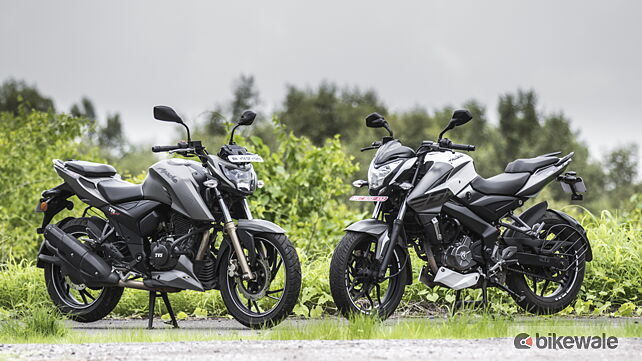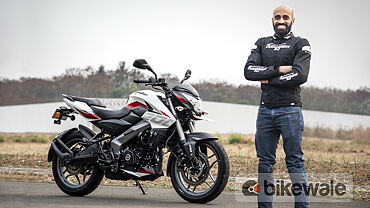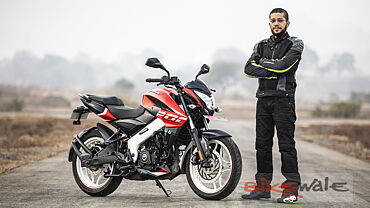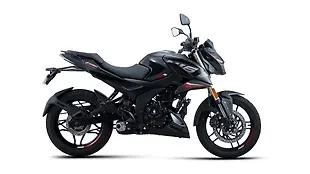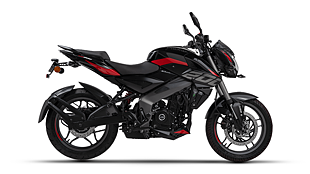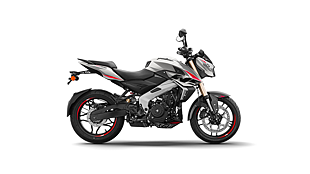Introduction

The 200cc motorcycle segment is looked at as a gateway to the world of entry-level performance bikes. There aren’t a lot of players in this segment but it is surely tempting for a few to make their presence felt. Bajaj offers the most products in this space– the Pulsar RS200, Pulsar AS200 (now discontinued), Pulsar NS200 and two more from the KTM family, the Duke 200 and RC200. Bajaj tested the waters with the Pulsar NS200, but it was discontinued later due to poor sales. But now, it is back and at a time when there’s a direct rival to it, the TVS Apache RTR 200 4V.
Looks

Naked bikes are incomplete without an aggressive demeanour and sharp styling. The previous iteration of the NS200 didn’t really beg for attention— blame the poorly chosen paint schemes and decals. But Bajaj has fixed that with the introduction of better dual-tone colour schemes and stickers that enhance the look. The NS200 is now able to show -off its body proportions correctly and it even gets a double-take from passersby. The current design best highlights the shoulder line, and that gives it a good road presence. The new belly-pan and the wheel rim tapes accentuates the Pulsar NS200.

The Apache RTR 200 is a well-designed bike. It gets the right amount of sharpness and can lure a customer into the showroom. The minimalistic design, angular fuel tank and double-barrel exhaust are all well thought out. The wheel design is very likeable, just like the headlamp unit. Other elements like the off-set fuel-lid and air scoops on the fuel tank are all sports bike inspired and add to its appeal.
Instrumentation, Riding position

The Pulsar NS200 and the Apache RTR 200, both have a well laid out instrument cluster. While the Pulsar NS200 gets analog as well as digital instrumentation, the Apache 200 is home to a fully digital one. In the Pulsar, the analog tachometer is housed in a circular unit which also has an integrated fuel indicator. Clock, speed, trip meters are displayed on the right side of the cluster in a small LCD screen. The RPM indicator glows every time you hit redline. The switchgear has backlight like the rest of the Pulsars.

The Apache has a large LCD screen which is really good to look at. It shows clock, gear indicator, speed, tachometer, fuel level and two trip meters. It also sports a lap timer and the adjustable shift light which is unique for a bike in the segment. The Apache has an edge over the Pulsar NS200 in the quality department. The usage of plastics and paint finish feels superior to Bajaj.

In terms of the riding position, the Pulsar NS200 offers a sportier experience. The clip-on handlebar is placed a little way from the rider, but it isn’t difficult to reach. The footpegs are lower and marginally rear-set. This makes it easy for speed junkies to go faster and have more fun. Crouch, open the throttle and blast away. The tank design also helps in placing the knees with ease, however, taller riders will face issues tucking in their knees due to their long legs.
The seat on the Pulsar is soft, and has the right amount of cushioning to keep you comfortable, just like the one on the Apache 200. The Apache is more commuting oriented and that makes everyone’s lives easy. The Apache offers a more relaxed riding stance, thanks to the closeness of the handlebar. The position of the pegs too, helps the overall riding experience. It is easier to stay on the Apache for a longer duration as the bike doesn’t feel cramped even for tall riders.
Performance and Handling

The Pulsar NS200 and the Apache RTR 200 both get the 200cc motor and are carbureted. However, the former is liquid-cooled and the latter is oil-cooled. The Pulsar makes 2.5bhp more than the Apache 200 at 23.2bhp. The Apache churns out 20.70bhp. The torque figure is almost similar for both bikes. 18.30Nm at 8000rpm for the Pulsar NS200 and 18.10Nm at 7000rpm for the Apache.

The Apache mill is smooth and responsive. A strong mid-range is the major trait of this 200cc motor. The power delivery is linear and it has enough grunt to reach 100kmph without much stress. There are vibes but they arrive only after the revs go beyond 9000rpm. The gearbox is a five-speed one that performs decently.

The Pulsar NS200 is surely more exciting here, thanks to the additional 2.5bhp. It also runs smoother and quieter than the TVS. The rev-happy nature of this motor makes it fun to ride everywhere. It delivers power linearly and can do 30kmph in fifth gear. The six-speed gearbox on this bike has improved drastically and doesn’t feel as notchy as before. The traditional Bajaj vibrations start coming in at 7000rpm and can be felt at the handle and foot pegs. In terms of fuel efficiency, the Apache is a clear winner at 42.36kmpl. The Bajaj Pulsar NS200 returned 36.53kmpl.

We’ve always been a big fan of Apache’s ride. It comfortably absorbs all bumps and undulations without any drama. The telescopic forks in the front and monoshock at the rear take care of all these. The Pulsar NS200, on the other hand, is set up slightly firmer. And this has been done to keep the handling aspect intact. Around corners, the NS200 is composed and feels like it belongs there. The Apache too, thanks to its manageable weight and light front, behaves well around corners. The brakes on the Apache are disappointing. They lack bite, power and feel. The brake setup on the Pulsar NS200 is excellent. There’s ample power at the front and it offers great feedback. The rear brake performs decently.
Verdict

The TVS Apache RTR 200 4V is the winner of this test. Both the bikes, the Apache 200 and the Pulsar NS200 offer the same value in terms of styling, performance, pricing and desirability. However, the Apache 200 gets an edge over the Pulsar in the ride quality and fuel efficiency departments and that is a deal breaker. If you’re in a market for a 200cc motorcycle that is city friendly, has excellent ride and also returns good fuel efficiency, look no further than the Apache RTR 200 4V.
Photography by Kapil Angane
Final Scores
| Parameters | Max Points | TVS Apache RTR 200 4V Carb | Bajaj Pulsar NS 200 |
| Rank | 1 | 2 | |
| Looks & styling | 10 | 8 | 8 |
| Ergonomics & Quality | 10 | 8 | 7.5 |
| Features & Tech | 10 | 6 | 6 |
| Engine & Gearbox | 10 | 7 | 7 |
| Performance | 10 | 7 | 7 |
| Ride Quality | 10 | 8 | 7 |
| Handling & Braking | 10 | 7 | 7.5 |
| Fuel Efficiency | 10 | 5 | 4 |
| Price & Warranty | 10 | 5 | 5 |
| Desirablility | 10 | 4 | 4 |
| Total | 100 | 65 | 63 |
Specifications
| Make | TVS | Bajaj |
| Model | Apache RTR 200 4V | Pulsar NS200 |
| POWER TRAIN | ||
| Engine Type | Oil-cooled | Liquid-cooled |
| Capacity | 197.7cc | 199.5cc |
| Max Power7 | 19.8bhp | 23.5bhp |
| Max Torque | 18.1Nm | 18.3Nm |
| Gearbox | 5 speed | 6 speed |
| Clutch | Wet, multiplate | Wet, multiplate |
| CYCLE PARTS | ||
| Chassis | Double cradle | Perimeter frame |
| Supension F | Telescopic | Telescopic |
| Suspension R | Mono shock | Monoshock |
| Brakes F | 270mm disc | 280mm Disc |
| Brakes R | 240mm disc | 230mm Disc |
| Tyre F | 90/90-17 Tubeless | 100/80-17 52 P Tubless |
| Tyre R | 130/70-17 Tubeless | 130/70-17 62 P Tubless |
| MEASURES | ||
| Fuel Tank | 12 litres | 12litres |
| LxWxH | 2050mm x 790mm x 1105mm | 2017mm x 804mm x 1205mm |
| Wheelbase | 1353mm | 1363mm |
| Kerb Weight | 148kg | 152kg |
| COST | ||
| Price (on-road, Mumbai) | Rs 1,07,207 | Rs 1,12,195 |
| Warranty | 2 years/30,000kms | 2 years/30,000kms |
Gallery
1/103
Bajaj Pulsar NS200 vs TVS Apache RTR 200 4V Comparison test
Double Tap to Zoom











